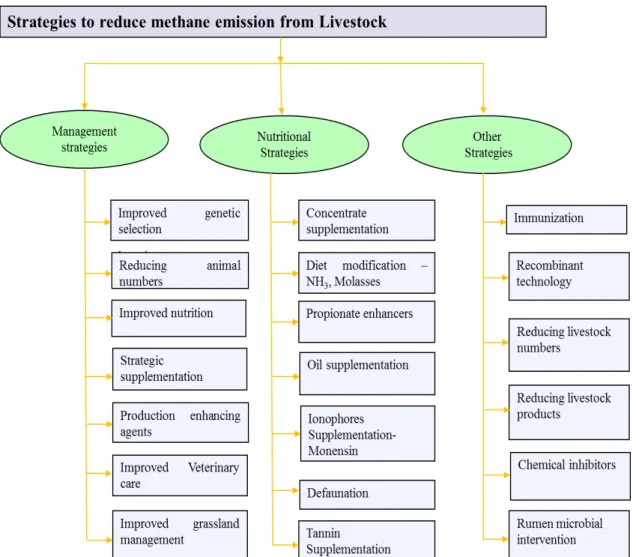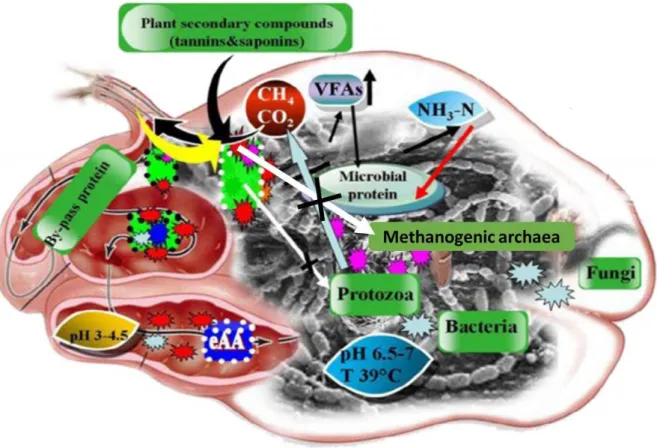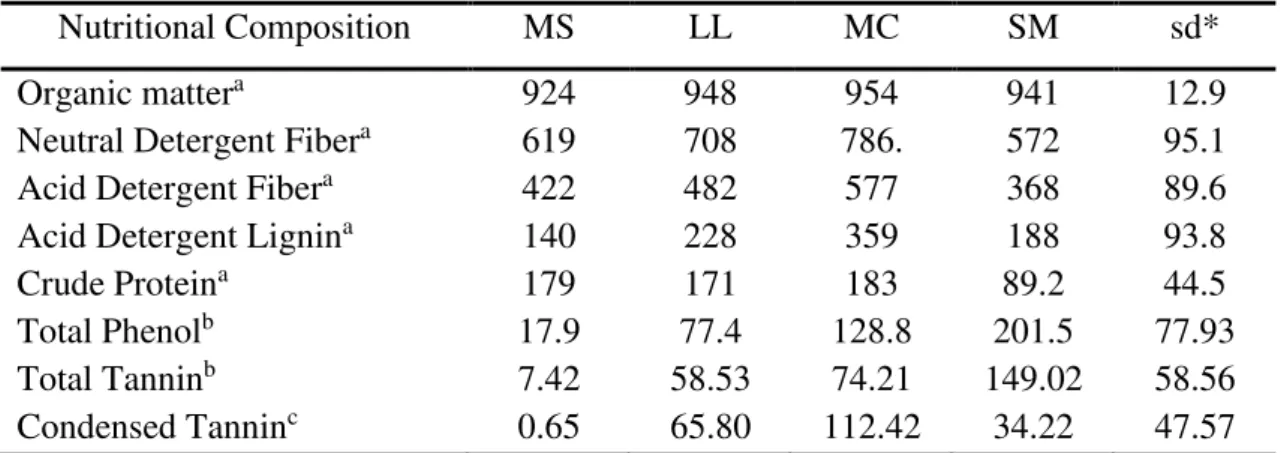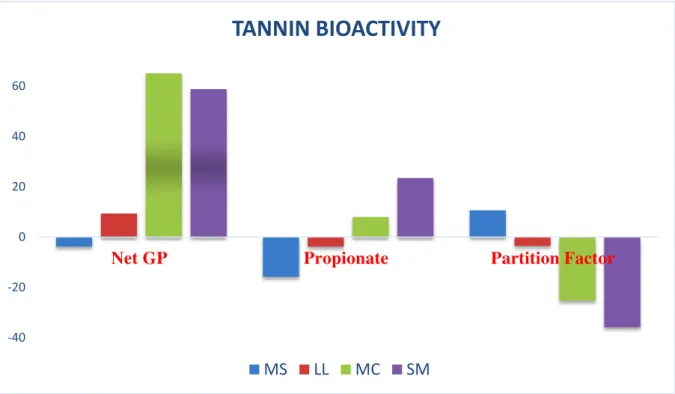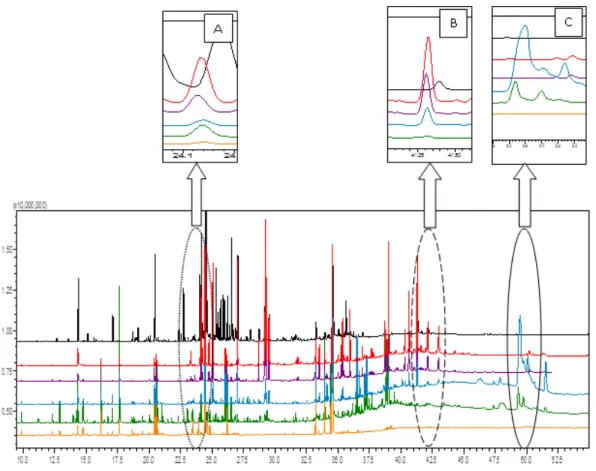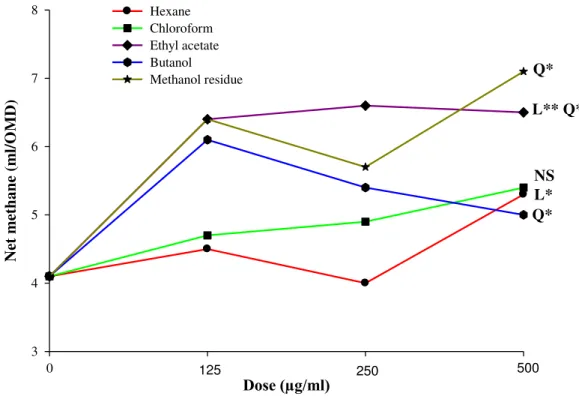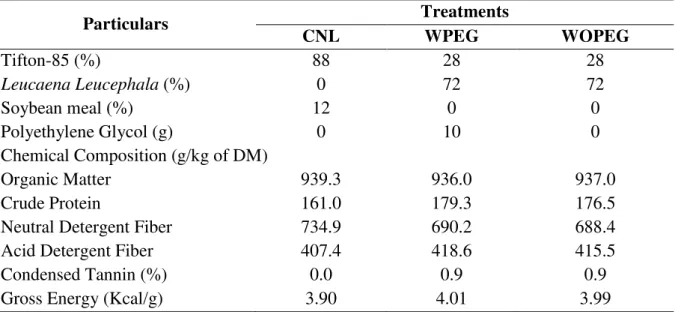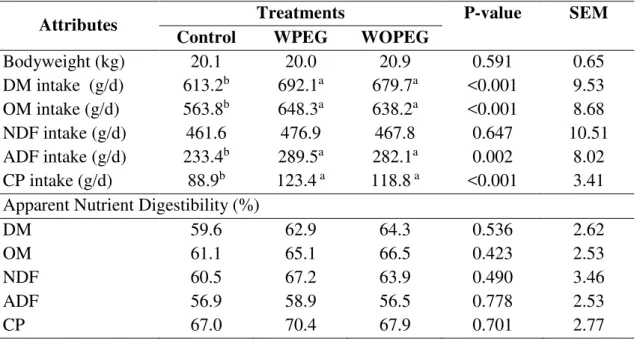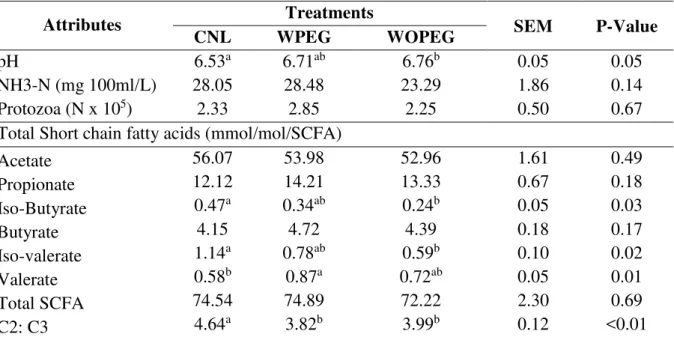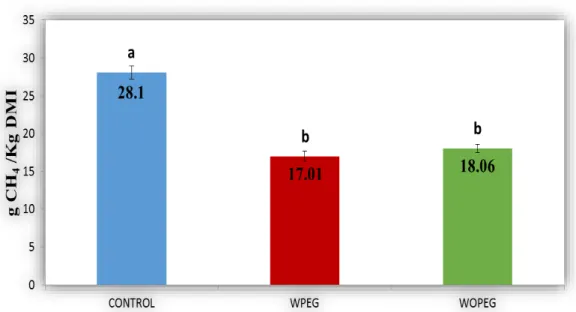UNIVERSIDADE DE SÃO PAULO
CENTRO DE ENERGIA NUCLEAR NA AGRICULTURA
DINESH KUMAR DHANASEKARAN
Mitigating the greenhouse gas balance of ruminant production by
identifying plants with high tannin concentration and quantifying the
methane emission in vivo
DINESH KUMAR DHANASEKARAN
Mitigating the greenhouse gas balance of ruminant production by
identifying plants with high tannin concentration and quantifying the
methane emission in vivo
Versão revisada de acordo com a Resolução GoPGr 6018 de 2011
Tese apresentada ao Centro de Energia Nuclear na Agricultura da Universidade de São Paulo para obtenção do título de Doutor em Ciências
Área de Concentração: Biologia na Agricultura e no Ambiente
Orientador: Prof. Dr. Adibe Luiz Abdalla
AUTORIZO A DIVULGAÇÃO TOTAL OU PARCIAL DESTE TRABALHO, POR QUALQUER MEIO CONVENCIONAL OU ELETRÔNICO, PARA FINS DE ESTUDO E PESQUISA, DESDE QUE CITADA A FONTE.
Dados Internacionais de Catalogação na Publicação (CIP)
Seção Técnica de Biblioteca - CENA/USP
Dhanasekaran Dinesh Kumar
Mitigating the greenhouse gas balance of ruminant production by identifying plants with high tannin concentration and quantifying the methane emission in vivo.
Mitigando o equilíbrio de gases do efeito estufa na produção de ruminantes pela identificação de plantas com concentração elevada de tanino e
quantificação das emissões de metano in vivo/ Dinesh Kumar Dhanasekaran; orientador Adibe Luiz Abdalla. - - versão revisada de acordo com a Resolução GoPGr 6018 de 2011. - - Piracicaba, 2016.
102 p.: il.
Tese (Doutorado – Programa de Pós-Graduação em Ciências. Área de Concentração: Biologia na Agricultura e no Ambiente) – Centro de Energia Nuclear na Agricultura da Universidade de São Paulo.
1. Mitigação de metano 2. Plantas taniníferas 3. Propriedades anti metanogênicas 4. Ruminantes 5. Segurança alimentar I. Título
நங்க ் ஒு ூ னைப்பபோ ் ி கோிக்க பே ் ு ்
எை் ோ ்,
ு ி ், ஒு ூ னைப்பபோ எ பே ் ு ்.
- ுனைவ ். ஏ. ி. ஜே. ப்ுல்கலா ்
ந்ி ாிை் 11 வுுி ு
தனலவ ்.
If you want to shine like a sun, first burns like a sun.
ACKNOWLEDGEMENTS
I wish to thank the Almighty, My parents, My wife, My brother and My relatives to whom I owe each and everything of this effort. And my special thanks to My uncle, My mom and My lover, who believe in me and support me in all my times.
I feel extremely pleasure to work under the guidance of Prof. Dr. Adibe Luiz Abdalla, Center for Nuclear Energy in Agriculture, University of Sao Paulo, Brazil. It was great pride to complete this work under his supervision. He was inspired and educated to me with his excellent way of teaching, guidance, constructive criticism and helpful suggestions throughout this project work.
I wish to express my sincere thanks to Prof. Dr. Helder Louvandini, Center for Nuclear Energy in Agriculture, University of Sao Paulo, Brazil for his kind help, moral support and your valuable suggestion in personal and professional life.
I would like to place on record my deepest sense of gratitude and heartfelt thanks to Dr. Tsai Siu Mui, Director, Center for Nuclear Energy in Agriculture, University of Sao Paulo, Brazil for permitting me to conduct my research program at this prestigious Institute.
I have great pleasure in expressing gratitude to Prof. Dr. Severino Matias de Alencar,
College of Agriculture “Luiz de Queiroz”, University of Sao Paulo, Piracicaba, Sao Paulo,
Brazil for extending all the required help in laboratory and give his valuable suggestion. I wish to express my sincere thanks to Prof. Dr. Adegbola T. Adesogan, Department of Animal Sciences, University of Florida, USA for granted me a short term research scholar training program for two months in his laboratory and encourage me and supported me to complete sucessfully my training program.
I am also grateful to Prof. Dr. Ives Claudio da Silva Bueno, Departament of Animal Science, University of Sao Paulo, Pirassununga, Sao Paulo for his support and his important suggestions in my qualification exam.
I am also thankful to Dr. Diego Barcelos Galvani, Embrapa Goats and Sheep, Brazilian Agricultural Research Corporation (Embrapa) who introduce me to my beloved Prof. Dr. Adibe Luiz Abdalla.
I wish to express my sincere thanks to Dr. Yosra Ahmed Soltan Abd El-Rahman, Faculty of Agriculture, Alexandria University, Egypt for his kind help and her valuable suggestion even out of country through Skype.
Research is never the effort of a single individual and it is a team work and many have put their effort in several ways to bring this thesis to completion.
I take this opportunity to acknowledge the cooperation extended by technical support of Mrs. Regina S. R. Peçanha, Mr. Lécio, Mr. Lecio A. Castilho and Mr. Everaldo E. M. dos Santos as well as all undergraduate student in Laboratory of Animal Nutrition, CENA for all their support and help during my PhD program.
From my bottom of the heart, I thank my friends and colleagues Tairon Pannunzio, Adibe Luiz Abdalla Filho, Gabriel Sakita, Alinne Schumann, Andressa Santanna Natel, Rafael Meneghini, Paulo Tavares, Guilherme, Juliano Issakowicz, Ana Claudia Koki Sampaio Issakowicz, Patrícia Pimentel, Patricia Louvandini, Bernardo Berenchtein, Ronaldo Lucas, Alessandra Romero, Rodrigo, Egon Hion Ieda, Erika Breda Canova, Linander, Tatiane Lissoni, Massarioli, Samy Cavalcante, Edgard, Suzana Coimbra, Jordana, Carina Nazato, Leticia de Abreu Faria, Thiago Bompadre and all intership student for supporting, helping, motivating and also teaching Portuguese. Once again, thank you very much, without you all, it is impossible to complete my PhD Program.
I would like to express my “Palmeiras supporter” friend Ms. Marilia Garcia to help in all my times from first day to the last day of submitting my thesis. You helped me in learning Portuguese and supported me. I am really thankful to you.
I wish to express my sincere thanks for entire staff in Center for Nuclear Energy in Agriculture, University of Sao Paulo, Brazil for supporting me even I am an International student and also secretariat for care, support and advice.
ABSTRACT
DINESHKUMAR, D. Mitigating the greenhouse gas balance of ruminant production by identifying plants with high tannin concentration and quantifying the methane emission in vivo. 2016. 102 p. Tese (Doutorado) – Centro de Energia Nuclear na Agricultura, Universidade de São Paulo, Piracicaba, 2016.
In Brazil, with the continued expansion of agriculture for supplying demands from international markets, progressive increases in emissions of greenhouse gases are expected. The purpose of the project was hypothesized with three major approaches, 1) Strategies to mitigate methane emission in small ruminant production systems; 2) Identify tropical plants and individual bioactive compound against methanogenic propertie and 3) In vivo evaluation
of the nutrients metabolism in Santa Ines sheep fed tropical plants. For this, we have performed three experiments. The first study (Expt. 1) was designed to determine the in vitro
effects of three tropical tannin rich plants such as Leucaena leucocephala (LL), Mimosa caesalpiniifolia (MC), Schinus molle (SM) and one non-tannin rich plant Medicago sativa
(MS) for their anti-methanogenic properties when used with and without polyethylene glycol (PEG). All plants had significantly (P<0.05) influenced the degraded organic matter (TDOM) and degraded neutral detergent fiber (DNDF), especially LL, which had most influence on these parameters compared to other tannin containing plants. LL had positive response on antimethanogenic effects; its nutrient degradability was higher than that of other tannin containing plants. The second study (Expt. 2) was set to evaluate the effect of different organic extracts from the whole plant methanolic extract (MHE) of LL on in vitro gas
production and to characterize the chemical constituents by using gas chromatography coupled with mass spectroscopy (GC-MS). Major abundant compounds present at the relative percentages of MHE were found to be stigmasterol trimethyl ester (TMS), neophytadiene, palmitic acid TMS, α-Linolenic acid TMS and 2, 3, 5, 6-tetra methyl anisylbenzene. The effects of additions of different extracts in terms of nutrient degradability (TDOM and DNDF) were increased by all extracts. This study explained that the methanolic hexane extract and methanolic chloroform extract was effective against methanogenic activity. The objective of the third study (Expt. 3) was to study the effect of LL plant leaves on rumen fermentation, apparent nutrient digestibility, nitrogen balance and methane production in Santa Ines sheep. The animals were divided in three groups in which they were fed with (i) 88% Tifton 85-hay (Cynodon spp.) and 12% soyabean meal (Control group, n=4); (ii) 28% Tifton 85-hay
(Cynodon spp.) and 72% LL plus 20 ml solution containing 10g/day/animal of PEG (With PEG group - WPEG, n=6); (iii) 28% Tifton 85-hay (Cynodon spp.) and 72% LL plus 20 ml of
distilled water (without PEG group- WOPEG, n=6). Nutrient intake (dry matter, organic
matter, acid detergent fiber, lignin and crude protein) were higher in WPEG and WOPEG compared to the control group, except neutral detergent fiber intake. Apparent digestibilities and nitrogen metabolism had non-significant effects between the treatments. However, CH4
emissions were significantly lower in WPEG and WOPEG than the control. Furthermore, expressions of microbial populations of methanogens in WPEG had lower tendency than that of WOPEG and control. The most salient findings of this study were that, 72% LL plant leaves using in small ruminants diets increased animal productivity, we can get more benefits in terms of replacing the source of protein in the diet (food safety) and reduced production of enteric CH4 (animal production).
RESUMO
DINESHKUMAR, D. Mitigando o equilíbrio de gases do efeito estufa na produção de ruminantes pela identificação de plantas com concentração elevada de tanino e quantificação das emissões de metano in vivo. 2016. 102 p. Tese (Doutorado) – Centro de Energia Nuclear na Agricultura, Universidade de São Paulo, Piracicaba, 2016.
No Brasil, com expansão da agricultura para suprir as exigências dos mercados internacionais, são esperados aumentos progressivos nas emissões de gases do efeito estufa. O objetivo do projeto foi hipotetisado com três abordagens principais, 1) estratégias para mitigar emissões de metano em sistemas de produção de pequenos ruminantes; 2) identificar plantas tropicais com compostos bioativos com propriedades antimetanogénicas e 3) avaliação in vivo do
metabolismo de nutrientes em ovelhas Santa Inês alimentadas com planta taninífera. Para isso, foram efetuados três experimentos. O primeiro estudo (Expt 1) foi concebido para estudar os efeitos in vitro de plantas tropicais ricas em taninos como Leucaena leucocephala
(LL), Mimosa caesalpiniifolia (MC) e Schinus molle (SM) e uma planta não taninífera, Medicago sativa (MS) quanto às propriedades antimetanogénicas quando usadas com e sem
polietileno glicol (PEG). Todas as plantas significativamente (P < 0.05) influenciaram na degradabilidade da matéria orgânica (MOD) e da fibra em detergente neutro (FDND), especialmente LL, que teve maior influência sobre estes parâmetros, em comparação com as outras plantas que contém taninos LL teve resposta positiva sobre os efeitos de antimetanogênicos e a degradabilidade dos nutrientes foi maior do que a das outras plantas que contém tanino. O segundo estudo (Expt 2) foi definido para avaliar o efeito de diferentes extratos orgânicos a partir do extrato metanólico da planta (EMP) de LL na produção de gases
in vitro e caracterizar os constituintes químicos usando cromatografia gasosa acoplada com
espectroscopia de massa (GC-MS). Os compostos mais abundantemente encontrados, em termos de percentagens relativas do EMP, foram o éster de trimetil estigmasterol, neofitadina,
ácido palmítico, ácido α-linolênico e 2, 3, 5, 6-tetra methyl anizilbenzeno. Os efeitos de adições dos diferentes extratos orgânicos, em termos de degradabilidade de nutriente (MOD e FDND) foram aumentados para todos os extratos. Este estudo explicou que o extrato de hexano a partir do EMP foi eficaz na atividade anti metanogênicas em modificar a degradação ruminal de nutrientes. O objetivo do terceiro estudo (Expt 3) foi estudar o efeito das folhas da planta LL na fermentação ruminal, digestibilidade aparente de nutrientes, balanço de nitrogênio e produção de metano em ovinos Santa Inês. Os animais foram divididos em três grupos em que eles foram alimentados com (i) 88% feno de Tifton-85 (Cynodon spp.) e 12%
de farelo de soja (Grupo controle, n = 4); (ii) 28% feno de Tifton-85 (Cynodon spp.) e 72%
LL mais 20 ml solução contendo 10g/dia/animal de PEG (grupo com PEG - CPEG, n = 6); (iii) 28% feno de Tifton-85 (Cynodon spp.) e 72% LL mais 20 ml de água destilada (grupo
sem PEG- -SPEG, n = 6). A ingestão de nutrientes (matéria seca, matéria orgânica, fibra em detergente ácido, lignina e proteína bruta) foram maiores no grupos CPEG e SPEG em relação ao grupo controle, exceto a ingestão de fibra em detergente neutro. As digestibilidades aparentes e o metabolismo do nitrogênio não apresentaram efeitos significativos entre os tratamentos. No entanto, as emissões de CH4 foram significativamente inferiores nos grupos
que nos grupos SPEG e controle. As conclusões mais relevantes do presente estudo foram que, usando 72% LL folha de planta em dietas de pequenos ruminantes, poderemos ter mais benefícios em termos de substituição da fonte de proteína da dieta (segurança alimentar) e redução da produção de CH4 entérico.
Palavras-chave: In vivo. Leucaena leucocephala. Propriedades anti metanogênicas.
LIST OF ABBREVATIONS
DM Dry matter
OM Organic matter
NDF Neutral Detergent Fiber
ADF Acid Detergent Fiber
ADL Acid Detergent Lignin
CP Crude Protein
TP Total Phenol
TT Total Tannin
CT Condensed Tannin
MS Medicago sativa
LL Leucaena Leucocephala
MC Mimosa caesalpiniifolia
SM Schinus molle
PEG Polyethylene Glycol
GP Gas Production
PRO Protoza
NH3-N Ammonia Nitrogen
C2 Acetate
C3 Propionate
C4a Iso-butyurate
C4b Butyurate
C5a Iso-Valerate
C5b Valerate
C2/C3 Acetate/propionate ratio. TSCFA Total short chain fatty acids CMAE Crude Methanolic Alfafa Extract CMLE Crude Methanolic Leucaena Extract
MHE Methanolic Hexane Extract
MCE Methanolic Chloroform Extract
MEE Methanolic Ethyl acetate Extract
MBE Methanolic Butanol Extract
MRE Methanolic Residue Extract
SCFA Short Chain Fatty Acids
TDOM Trully Degraded Organic Matter
PF Partition Factor
GC-MS Gas Chromatography Mass spectrophotometer
GC Gas Chromatography
TMS Trimethylsilylester
CENA Center for Nuclear Energy in Agriculture
CH4 Methane
CNL Control
WPEG With PEG
WOPEG Without PEG
SUMMARY
1. INTRODUCTION ... 17
1.1 INTRODUÇÃO ... 21
2. LITERATURE REVIEW ... 25
2.1 Methanogenesis of rumen fermentation ... 25
2.2 CH4 mitigation strategies ... 26
2.3 Brazilian tropical plants tested for methane mitigation ... 28
2.3.1 Leucaena leucocephala ... 28
2.3.2 Mimosa caesalpiniifolia ... 29
2.3.3 Schinus molle ... 29
2.4 Tannins and their effects in rumen ecosystem... 29
2.4.1 Tannins ... 29
2.4.2 Tannin Binding Agents ... 30
2.4.3 Effect of tannins on CH4 production ... 31
2.4.4 Effect of tannins on rumen fermentation ... 32
References ... 34
3 Effect of native tropical plant species on in vitro rumen fermentation and methane emission ... 42
3.1 Introduction ... 43
3.2 Material and methods ... 44
3.2.1 Plant source and their chemical composition ... 44
3.2.2 In vitro gas production ... 44
3.2.3 Statistical analysis ... 45
3. 3 Results ... 46
3.3.1 Effects on chemical composition ... 46
3.3.2 Effect on total gas production, nutrient degradability and partition factor ... 46
3.3.3 Effect on tannin bioactivity ... 48
3.3.4 Effect on in vitro ruminal parameters ... 48
3.4 Discussion ... 50
3.4.1 Effects on chemical composition ... 50
3.4.2 Effects on total gas production, nutrient degradability and partitioning factor ... 50
3.4.3 Effects on tannin bioactivity ... 52
3.5 Conclusions ... 53
References ... 53
4 Isolation and characterization of chemical components of Leucaena leucocephala for anti-methanogenic properties by using gas chromatography and mass spectroscopy (GC-MS) ………... 59
4.1 Introduction ... 60
4.2 Material and Methods ... 61
4.2.1 Laboratory analysis ... 61
4.2.2 Extraction method ... 61
4.2.3 GC-MS Analysis. ... 62
4.2.4 Treatments and experimental design... 62
4.2.5 In vitro ruminal parameters. ... 63
4.2.6 Statistical data analysis ... 64
4.3 Results and Discussion... 64
4.3.1 Compounds identified in different extracts ... 64
4.3.2 Effect on gas production ... 68
4.3.3 Effect on nutrient degradability ... 70
4.3.4 Effect on Ruminal Parameters ... 72
4.4 Conclusions ... 72
References ... 72
5 Effect of available human inedible resources (Leucaena leucocephala) to improve animal productivity and methane mitigation ... 78
5.1 Introduction ... 79
5.2 Material and Methods ... 80
5.2.1 Diets preparation ... 80
5.2.2 Experimental animal and housing ... 81
5.2.3 Nutrient intake, apparent digestibility and N balance ... 82
5.2.4 Rumen fluid analysis ... 82
5.2.5 Microbial protein synthesis by purine derivatives ... 83
5.2.6 Estimation of CH4 productions ... 84
5.2.7 Relative expressions of microbial populations ... 84
5.2.8 Statistical Analysis ... 85
5.3 Results ... 85
5.3.1 Nutrient intake and apparent digestibility ... 85
5.3.3 Ruminal parameters ... 87
5.3.4 Enteric CH4 production ... 87
5.3.5 Rumen microbial populations ... 88
5.4 Discussion ... 88
5.5 Conclusions ... 94
References ... 94
1. INTRODUCTION
Climate change is one of the major threats on our planet with increasing population and also economical demand (SKUCE et al., 2013). According to the International Panel of Climate Change (IPCC) reported that rate of climate change is faster than never before in the last 1000 years and there is a possibility that the rise of average global temperatures between 1.80C and 4.00C within the next 90 years (YATOO et al., 2012). Hence, the impacts of global
climate change is predominately threatening factors for the well-being of current and future generations (MARINO et al., 2015).
Livestock sector plays a very important contribution towards to the greenhouses gas emissions (GHGE) worldwide (i.e carbon-di-oxide (CO2), methane (CH4) from enteric
fermentation and nitrous oxide (N2O) from manure management (GERBER et al., 2011).
Steinfield et al. (2006) estimated that this sector emits around 18% of total global anthropogenic GHG emissions. With increasing global population growth in developing countries, which demands more quantity of food products with lower environmental impact associated with their production. Hence, researchers are being focus on these aspects in the livestock sector (STEINFELD et al., 2006; GODFRAY et al., 2010). In particular, small ruminant sector plays a crucial worldwide socio-economic importance in terms of animal production and environmental performance. Sheep and goats represents about 56% on the global ruminant population. However, small ruminant populations are located in three different zones (56%-arid; 27%-temperate and 21%-humid) (MARINO et al., 2015). Foresight et al. (2011) reported that the expected rise of sheep numbers is around to be 60% by 2050. During past two decades, goats and sheep produce more than 28 million tons of milk and 13 million tons of meat respectively (FAOSTAT, 2013). Therefore, there is a strong interest in small ruminant sector, which is a very good model to evaluate the ruminant production systems in terms of animal performance and also measuring environmental impacts.
In Brazil, with the continued expansion of agriculture supplying demands from international markets, progressive increases in emissions of methane, nitrous oxide and carbon dioxide are expected. Enteric fermentation by ruminants, manure management and rice cultivation plus fuel burn of agricultural residues were accountable for 73%, 3% and 2% of total methane emitted in Brazil respectively (CERRI et al., 2009). Land use changes (19%) and industrial processes (3%) also accounted for the total 340 Mt CO2 eq of Brazilian
represented by cattle, a significant portion composed of small ruminants such as sheep and goats is in the Northeast states in Brazilian with different production systems, mostly extensive, based on grazing in the Caatinga, an important ecosystem of the semiarid region whose occupancy is approximately 60% of the area in Northeastern region.
In developing countries, animals have been an important factor in integrated livestock-crop farming systems. Animals have diversified role on production of animal protein and useful in farm manure as well as improving people livelihoods (WANAPAT et al., 2010). With expected global population growth increases around 8.3 billion people in the year 2030, it is essential to produce sufficient amount of food from locally available resources especially in developing countries. Level of consumption of animal food is increase from 10 kg/yr (1960) to 26 kg/yr (2000) and there is expected to rise up to 37 kg/yr in 2030 (FAO, 2008; 2009; WANAPAT et al., 2013). Most importantly, ruminant animals will continue as predominant factor on animal agriculture due to conversion of human inedible materials such as tree fodder, roughage, crop residue and by-products into human food. Hence, it is necessary to use locally available human inedible resources to increase animal productivity. Furthermore, Wanapat et al. (2009) reported that utmost importance of local available feed resources for ruminants to increase the animal production. There is a growing realization that mitigation action may not be isolated and it should be packed with increase in animal productivity and thus deliver against food security. Therefore, nowadays researchers are being focus on mitigation strategies and potentials that simultaneously improving animal productivity in terms of food security and livelihoods of farmers.
There are many mitigation practices used to reduce enteric CH4 emissions and
improve livestock productivity. However, several countries are restricting the availability of some mitigation options. For example, European Union banned antibiotics use in animal feeds due to human food safety (EUROPEAN UNION, 2003). Use of tannin containing plants have been studied and show the most promise for mitigating enteric CH4 emissions. Beauchemin et
al. (2007) reported that, tannin has potential for reducing enteric CH4 emission by up to 20
percent. Tannins are being reported as anti-nutritional; at lower concentration it improves animal productivity in terms of alterations of ruminal fermentation and microbial protein synthesis (BHATTA et al., 2012).
the tannin effects on rumen fermentation for certain plant species by in vitro techniques. It is a
simple and effective tool, irrespective of their chemical nature. Hence, researchers had an opportunity to exploit plants and plant secondary metabolites as natural alternatives to improve livestock productivity.
Ruminant production in tropical region is generally based on forage grasses contain high amount of fiber and lignin content, which are being digested and loss of excessive energy to produce CH4 and it represents loss of 8-12% gross energy (ABDALLA et al., 2012).
In particular, higher CH4 is produced, when diet based on grasses compared to the legumes
based diets (GOEL; MAKAR, 2012). In this context, Leucaena leucocepahala (LL) has
several attributes such as highly nutritious leguminous forages and it can provide firewood, shade and control in soil erosion. LL leaves contains high level of protein (which can able to replace soyabean meal in ruminants diets) and it also contains tannins (it could reduce CH4
production). However, several studies reported that LL can be to improve ruminal fermentation in terms of metabolic protein supply due to its high protein content (SALLAM et al., 2010; SOLTAN et al., 2012). Similiarly, LL has been shown anti-methanogenic properties
in vitro and in vivo (SOLTAN et al., 2012; 2013). In addition, compounds present in LL can
improve rumen function with increase in number of microbial growth especially cellulolytic and proteolytic bacteria (HOOVER; STOKES, 1991; TAN et al., 2011).
Furthurmore, there are another mitigation options such as feed additives to improve livestock productivity. Feed additives are included into animal diets to improve feed quality, growth, nutrient deficiency, adsorb toxins, breakdown of anti-nutritive factors and reduce methane production in the rumen (DURMIC et al., 2014). Many researches in the last two decades have been focused on the effects of ionophores and antibiotics on ruminal fermentation (RUSSELL, 1987). In other hand, supplement of probiotics into the rumen microorganisms, which increase propionate or butyrate and reduce the protozoa number resulted reduction in methane (IQBAL et al., 2008). But, usage of probiotics in large scale production to mitigate CH4 emissions is very expensive. Therefore, use of plant extracts
containing high level of plant secondary metabolites will improve animal performance and resolve human safety issues. Several studies emphasized that group of plant secondary metabolites (e.g. saponins, flavonoids, and tannins) seems to present the ability to manipulate rumen fermentation in a favorable way thus lessening the CH4 formation (HRISTOV et al.,
The hypothesis of this work was the quantification of methane emissions in sheep under different feeding systems, using tropical plants or plant extracts as promising element to explain the use of tropical plants in ruminant diets in terms of food security and reduction of greenhouse gases.
The overall objective of the work was hypothesized with three main approaches: 1) strategies to mitigate methane emissions in small ruminant production systems; 2) identification of tropical plants and bioactive compounds with anti-methanogenic properties; 3) in vivo evaluation and performance of Santa Inês sheep fed with selected
tropical plants.
The specific objectives were to determine the effects of tanniniferous tropical plant
Leucaena leucocephala (LL), Mimosa caesalpiniifolia (MC) and Schinus molle (SM), for its
anti-methanogenic properties when used with and without polyethylene glycol (PEG), as well as to evaluate the effect of different organic extracts from the methanolic extract of LL in
upon the in vitro gas production and degradability and in addition, to characterize the
chemical constituents using gas chromatography and mass spectroscopy (GC/MS). In vivo,
the objective was to evaluate the effect of LL on ruminal fermentation, nutrient digestibility,
1.1. INTRODUÇÃO
As mudanças climáticas constituem uma das principais ameaças do nosso planeta com o aumento da população e também com a demanda econômica (SKUCE et al., 2013). O Painel Internacional de Mudanças Climáticas (PIMC) informou que a taxa da mudança climática é mais rápida dos últimos 1000 anos e que possivelmente haja um aumento das temperaturas médias globais em torno 1,8 e 4,0 °C nos próximos 90 anos (YATOO et al., 2012). Assim, os impactos dessa mudança climática global são, predominantemente, fatores que ameaçam o bem-estar das gerações atuais e futuras (MARINO et al., 2015).
A pecuária contribui expressivamente para as emissões de gases de efeito estufa (GEE) (tais como, dióxido de carbono - CO2, metano - CH4, proveniente da fermentação
entérica e óxido nitroso - N2O, proveniente do manejo de dejetos) em todo o mundo
(GERBER et al., 2011). Com o aumento do crescimento populacional nos países em desenvolvimento, exige-se maior quantidade de produtos alimentares com menor impacto ambiental associado com a sua produção. Nesse sentido, os investigadores estão focados sobre estes aspectos no setor da pecuária (STEINFELD et al., 2006; GODFRAY et al., 2010). Em particular, o setor de pequenos ruminantes tem uma importância socioeconômica mundial crucial em termos de produção animal. Ovinos e caprinos representam cerca de 50% da população mundial de ruminantes. No entanto, esse efetivo está localizado em três diferentes zonas: 56% árida, 27% temperada e 21% úmidas (MARINO et al., 2015). Foresight et al. (2011) relatam um possível aumento de cerca de 60 % do rebanho ovinos em 2050. Durante as duas décadas passadas, caprinos e ovinos produziram mais de 28 milhões de toneladas de leite e 13 milhões de toneladas de carne, respectivamente (FAOSTAT, 2013). Portanto, há um forte interesse no setor de pequenos ruminantes, que é um bom modelo para avaliar os sistemas de produção em termos de desempenho animal e também a avaliação dos impactos ambientais.
No Brasil, com a contínua expansão da agricultura para o suprimento das demandas dos mercados internacionais, são esperados aumentos significativos nas emissões de metano, óxido nitroso e dióxido de carbono. A fermentação entérica de ruminantes, o manejo de dejetos e cultivo de arroz, mais consumo de combustível de resíduos agrícolas foram responsáveis por 73, 3 e 2 % do total de metano emitido no Brasil, respectivamente (CERRI et al., 2009). Mudanças no uso da terra (19 %) e processos industriais (3 %) também foram responsáveis pelo total de 340 Mt CO2 eq das emissões Brasileiras em 2010 (ABDALLA et
uma parcela significativa composta de pequenos ruminantes, como ovinos e caprinos está na região nordeste do Brasil com diferentes sistemas de produção, principalmente o extensivo, com base em pastejo na Caatinga, um importante ecossistema da região semiárida, cuja ocupação é de aproximadamente 60 % da área do nordeste.
Em países em desenvolvimento, os animais têm sido um importante fator nos sistemas de integração lavoura-pecuária. Nessas regiões os animais ruminantes têm importante função na produção de proteína animal, assim como na melhoria de vida da população (WANAPAT et al., 2010). Com o esperado aumento do crescimento populacional, em torno de 8,3 bilhões de pessoas em 2030, é essencial produzir quantidade suficiente de alimento em regiões com recursos disponíveis, especialmente em países em desenvolvimento. O nível de consumo de alimentos de origem animal aumentou de 10 em 1960 para 26 kg/ano em 2000 e é esperando subir para 37 kg/ano em 2030 (FAO, 2008; 2009; WANAPAT et al., 2013). O mais importante é que, os animais ruminantes continuarão como fator predominante na produção animal devido à sua capacidade de converter alimentos não utilizados na alimentação humana como forragem, volumoso, resíduos de culturas e subprodutos em produtos de alta qualidade para alimentação humana.
Assim, é necessário usar recursos forrageiros localmente disponíveis para aumentar a produtividade animal (WANAPAT et al., 2009). Há uma percepção crescente de que as medidas de mitigação não podem ser isoladas e deve estar em conexão com o aumento da produtividade animal e, assim, oferecer uma maior segurança alimentar. Portanto, hoje em dia os pesquisadores estão focando em estratégias de mitigação e potenciais que simultaneamente melhoram a produtividade animal em termos de segurança alimentar e meios de subsistência dos agricultores.
Muitas práticas de mitigação foram utilizadas para reduzir as emissões de CH4
entéricos. No entanto, vários países estão restringindo algumas dessas práticas. Por exemplo, a União Européia proibiu uso de antibióticos na alimentação animal devido à segurança alimentar humana (EUROPEAN UNION, 2003). O uso de plantas taniníferas tem sido estudado, mostrando ser muito promissor para na mitigação das emissões de CH4 entérico.
Beauchemin et al. (2007) relataram que o tanino tem potencial para reduzir 20 % da emissão de CH4 entérico. Contudo, os taninos contém propriedades anti-nutricionais, mas em baixas
A região semiárida do nordeste do Brasil possui uma grande extensão territorial composta por pastagem natural do tipo de savana, caracterizada por diferentes comunidades de plantas, arbustos, árvores e herbáceas. Pesquisadores têm buscado explorar as plantas e metabólitos secundários contidos nessas plantas como alternativas naturais para melhorar a produtividade animal.
A produção de ruminante em região tropical é geralmente baseada em forragens que contem alta quantidade de fibra, que ao serem digeridos, promovem excessiva perda de energia para produção de CH4, representando de 8-12% de perda da energia bruta consumida
(ABDALLA et al., 2012). Em particular, maior quantidade de CH4 é produzida quando a dieta
é baseada em forragens à base de gramíneas, quando comparado com dieta baseada em leguminosas (GOEL; MAKAR, 2012).
Nesse contexto, Leucaena leucepahala (LL) possue vários atributos, como ser
altamente nutritiva, podendo fornecer lenha, sombra e controle da erosão do solo. As folhas de LL contém alto nível de proteína, que pode substituir a soja na dieta de ruminantes e contém também taninos, que podem reduzir a produção de metano entérico. Vários estudos reportaram que LL pode melhorar a fermentação ruminal em termos de fornecimento de proteína metabólica, devido ao seu alto teor de proteína (SALLAM et al., 2010; SOLTAN et al., 2012). Semelhantemente, LL tem mostrado propriedades anti-metanogênicas in vitro e in vivo (SOLTAN et al., 2012; 2013). Em adição, compostos presentes na LL podem melhorar a
função ruminal com aumento no número de microrganismos, especialmente bactérias celulolíticas e proteolíticas (HOOVER; STOKES, 1991; TAN et al., 2011).
O uso de plantas ou extrato de plantas contendo alto nível de metabólitos secundários pode melhorar o desempenho animal e auxiliar nas questões de segurança alimentar. Vários estudos enfatizaram que metabólitos secundários de plantas (como as saponinas, flavonoides e taninos) têm a capacidade de manipular a fermentação ruminal favorecendo a redução da formação de CH4 (HRISTOV et al., 2013).
O objetivo geral do trabalho foi hipotetisado com três abordagens principais: 1) estratégias para mitigar emissões de metano em sistemas de produção de pequenos ruminantes; 2) identificação de plantas tropicais e compostos bioativos com propriedades anti-metanogénicas; 3) avaliação in vivo de desempenho de ovinos Santa Inês alimentados com
plantas tropicais selecionadas.
Os objetivos específicos foram determinar os efeitos das plantas taniníferas tropicais
Leucaena leucocephala (LL), Mimosa caesalpiniifolia (MC) e Schinus molle (SM), por suas
propriedades anti-metanogênica e quando usadas com e sem polietileno glicol (PEG), bem como avaliar o efeito de diferentes extratos orgânicos a partir do extrato metanólico da planta de LL na produção de gases e degradabilidade in vitro; além de caracterizar os constituintes
químicos usando cromatografia gasosa e espectroscopia de massa (CG-EM). In vivo,
2. LITERATURE REVIEW
2.1. Methanogenesis of rumen fermentation
Fermentation in the rumen is a complex process, enteric fermentation yields major SCFA (acetate, propionate and butyrate), fermentation acids, alcohols and other minor SCFA in which CH4 and CO2, H2 and NH3 gases are primary by-products of rumen fermentation.
Production of CH4 is the pathway of H2 clearance in rumen fermentation (JANSSEN et al.,
2010). Murray et al. (1976) estimated that, 89% enteric methane production is excreted through the lungs and only 11% through the rectum. Majority of enteric CH4 production
occurs in the reticulo-rumen and slight in hindgut region.
Simple and complex carbohydrates are converted into simple sugar with the help of microbial enzyme activity. In addition, simple sugars are fermented into SCFA and further several reactions occur to produce metabolic hydrogen. Conversion of metabolic hydrogen into H2 by hydrogenase-expressing bacterial species and in presence of Archaea, H2 is
converted into CH4 with the combined reaction. This process is summarized in the following
equations as described by (HUNGATE, 1966; CZERKAWSKI, 1986; MOSS et al., 2000).
Glucose → 2 Pyruvate + 4H [1] (Carbohydrate metabolism)
Pyruvate + H2O → Acetate + CO2 + 2H [2]
Pyruvate + 4H → Propionate + H2O [3]
2 Acetate + 4H → Butyrate + 2H2O [4]
CO2 + 8H → CH4 + 2H2O (methanogenesis) [5]
The end product H2 is necessary to be removed from the rumen ecosystem, otherwise
it can inhibit metabolism of rumen microorganisms. In addition, CH4 production is produced
only by anaerobic conditions by highly-specialized methanogenic bacteria that belong to the archaea domain, which are divided into five different form namely Methanosarcinales, Methanomicrobiales, Methanobacteriales, Methanococcales and Methanopyrales (QIAO et al., 2014).
Rumen is the chamber for billions numbers of bacteria, methanogens, protozoa and fungi. For instance, microbial populations of methanogenic archaea in concentrate based fed ruminants diets is about 107 to 109/g of rumen contents and in pasture based ruminants diets is
many species that have been isolated with the application of molecular technologies and it confirms the considerable genetic diversity in methanogens in the rumen ecosystem.
Recently, Poulsen et al. (2013) has identified unknown methanogens that use of methyl groups and H2 to produce CH4. Metabolic pathway in terms of methyl groups with
three reactions (Hydrogenotrophic, Methylotrophic and Aceticlastic) as follows (HILL et al., 2016).
CO2 + 4H2→ CH4 + 2H2O (Hydrogenotrophic) [6]
CH3OH + H2→ CH4 + H2O [7]
4CH3OH → 3CH4 + CO2 + 2H2O [8]
CH3NH2 + H2→ CH4 + NH3 (Methylotrophic) [9]
CH3COOH → CO2 + CH4 (Aceticlastic: minor reaction in the rumen) [10]
2.2CH4 mitigation strategies
There are several mitigation practices to reduce enteric CH4 emissions. According to
Figure 2.1. Strategies to reduce methane emission from livestock. (Source: SEJIAN et al., 2011)
Out of these strategies, the present project was conceptualized with nutritional approaches such as tannin supplementation. Tanniniferous plants and plant extracts in ruminant diets are being considered to be prominent strategies to reduce CH4 emissions
(HRISTOV et al., 2013). Briefly, the role of plant secondary compounds (PSC) such as tannin into rumen ecosystem, which has affinity towards protein to form tannin-protein complex and this complex will not be disintegrating in the rumen. Hence, protein reaches abomasum contains dietary protein and microbial protein which could be observed with lower production of NH3-N. In other hand, tannins influence on decreasing methanogenic archaea
2.3Brazilian tropical plants tested for methane mitigation
Brazil has biggest biodiversity in the world. It is estimated that 20% of planet biodiversity is found in Brazil. It has considerable territorial extension composed of savanna type natural grassland, characterized by different communities of plants, shrubs, trees, and little herbaceous. There are some 43,000 to 49,000 plant species (CONVENTION ON BIOLOGICAL DIVERSITY, 2012), therefore, a few tanniferous plants were tested for methane mitigation and also replacing protein supplements in ruminants by using locally available resources (ABDALLA et al., 2012; SOLTAN et al., 2013).
2.3.1. Leucaena leucocephala (LL): (Bra: Leucaena)
Leucaena leucocephala (Lam.) de Wit (leucaena) is a fast growing tree and also
known as the 'miracle tree' because of its worldwide invaded including in Brazil (INSTITUTO HÓRUS DE DESENVOLVIMENTO E CONSERVACÃO AMBIENTAL, 2014) Spain (DANA et al., 2003), Taiwan (CHEN et al., 2012), and Australia (WALTON, 2003). However, it is a native to Mexico and Central America. These plant species has several attributes such as highly nutritious forage tree and it can provide firewood, shade and control
in soil erosion. Botanically, LL belongs to the Mimosaceae family and it may grow upto 7-18 metres. LL leaves have also been shown as potential ruminants diets in terms of metabolic protein supply due to high protein content (SALLAM et al., 2010; SOLTAN et al., 2012) and LL has been shown anti-methanogenic properties under in vitro and in vivo studies
(SOLTAN et al., 2012; 2013).
2.3.2. Mimosa caesalpiniifolia (MC): (Bra: Sabia)
Mimosa caesalpiniifolia Benth is a tree-sized legume and it is native to the Northeast
region of Brazil. It also occurring in dry areas, where assumes shrubby (MAIA, 2004). It has the potential to be used as fodder by presenting high protein and nutrients making it an option to increase animal production especially during the dry season. It is well accepted by the animals, but may have limitations in use as forage for presenting branches with thorns, hindering the management and use of the plant (LIMA et al., 2008). Its foliage is a valuable feed source for large and small ruminants, especially during the dry due to the high nutritional value containing about 17 % crude protein (COSTA et al., 2011).
2.3.3. Schinus molle (SM): (Bra: Aroeira-celery)
Schinus molle is a tree which belongs to the Anacardiaceae family. The plant
occurring has been reported from Minas Gerais to Rio Grande do Sul especially southern
states of Brazil. In addition, it’s found mainly in dry and sandy soils. It can also adapt to low fertility and stony land. It has morphological characteristics such as heights (4-8m) and leaves compound with yokes (1-12) and paniculate inflorescences terminals (LORENZI et al., 2002). Supplementation of different levels of SM can decrease gas production and organic matter degradability significantly with increasing level of supplementation, however, authors concluded that low level of SM had potential supplements to alter rumen fermentation (ONENC et al., 2013).
2.4Tannins and their effects in rumen ecosystem
2.4.1 Tannins
capacity to form complexes with proteins due to presence of number of phenolic hydroxyl groups on their chemical structure (MUELLER-HARVEY, 2006).
Hydrolysable tannins (HT) are composed of polyol (glucose, glucitol, quinic acids, quercitol and shikimic acid) as a central core and it is esterified with a phenolic group. Hydrolysable tannins compound such as Gallic and Ellagic acid (PATRA; SAXENA, 2011). However, condensed tannins (CT) or proanthocyanidins tend to occurs as complex mixture of flavan-3-ol (epi) catechin and (epi) gallocatechin units with the interflavonoid linkages of C4–C8 and C4–C6 (FERREIRA et al., 1999). There are many other monomeric units (profisetinidins, probinetidins and proguibortinidins) found in condensed tannin (HASLAM, 1989). Quebracho tannins contains mainly profisetinidins (HEMINGWAY, 1989).
There are several colorimetric methods to analyse different tannins, but there are few studies to quantify tannin in their chemical structures in terms of monomeric composition or mean degree of polymerization (mDP) (GEA et al., 2011). By using this chemical degradation (thiolytic degradation method), we can be to quantify tannins upto molecular weight of 55000 daltons (GUYOT et al., 2001).
2.4.2 Tannin Binding Agents
To determine the adverse effects of tannins in browse species on rumen metabolism on
in vitro and in vivo experiment by using polyethylene glycol or polyvinyl pyrrolidine (PVPP)
as a tannin binding agents forming tannin-PEG or tannin PVPP complexes have been widely used (MAKKAR et al., 1995; TOLERA et al., 1997). In order to identify the most promising tannin complexing agents were investigated on the binding efficiency of PEG (molecular weight 2000-35,000) and PVPP (molecular weight 10,000, 40,000 and 3, 60,000) (MAKKAR, 2003; BESHARATI; TAGHIZADEH, 2011). PEG 6000 may be preferred for tannins inactivation in feedstuffs as its binding to tannins was highest at near neutral pH values (MAKKAR, 2003).
Bueno et al. (2008) reported that increase in gas production with and without binding agents such as PEG/PVPP on in vitro gas production technique. Results suggested that
control diets, resulted on enhanceing protein digestibility, microbial protein synthesis and ruminal parameters (ABARGUUEI et al., 2010).
2.4.3 Effect of tannins on CH4 production
Tanninferous plants as feed supplement shows the most potential mitigation options with 20% reduction of CH4 emissions (ZHOU et al., 2011; STAERF et al., 2012; HRISTOV
et al., 2013). However, some tannins may be ineffective for anti-methangenic effect due to structure, molecular weight and concentration of the tannin. For example, Bhatta et al. (2009) reported that certain plants containing both HT and CT were higher potential as CH4 reducers
than those plants containing only HT.
There are three types of mechanism of action proposed on tannin against methanogensis process (TAVENDALE et al., 2005; HESS et al., 2003), they are: (i) direct effect on rumen microbes, (ii) indirect effect to decrease hydrogen production in terms of fiber digestion and (iii) inhibitory effects of tannin on rumen methanogensis with protozoa associated CH4 production. In addition, Goel and Makkar (2012) review that HT showed
inhibition of methanogens or hydrogen producing microbes (i.e direct effect) and CT had decrease CH4 production in terms of fiber digestion (i.e indirect effect). Several studies have
been confirmed to decrease CH4 emissions by in vitro and in vivo experiment using
tanniferous plant and extracts (HRISTOV et al., 2013).
Patra et al. (2006) reported that addition of methanol extract of T. chebula plant
reduced methane emission. Populus deltoides leaf extracts were subjected into in vitro
experiment showed that decrease in methane production with highest dosage (PATRA et al., 2008). Furthermore, Kim et al. (2013) found that, pine needles and gingko leaf extracts appears to have antimethanogenic properties by decreasing protozoa species. On the other hand, Patra et al. (2006) reported that, Populus deltoides leaves inhibited methanogenesis
process without adversely affecting other rumen characteristics. Similarly, reduction of CH4 production (P<0.05) in plants such as Leucaena (88%) and Acacia (89%) in which were
subjected into in vitro gas production technique (SALLAM et al., 2010). The author attributes
the methane reduction was due to direct effect on methanogens and indirect inhibitory effects on reduced H2 production due to OM degradability. Psidium guajava leaves showed
promising effects on antimethanogenic properties and also coupled with defaunting property due to tannin content (CHATTERJEE et al., 2014). Abdalla et al. (2012) reported that the in vitro effect of Mimosa caesepiniifolia plant showed lowest CH4 production with relation to
Subsequently, Abdalla et al. (2012) performed in vivo experiment by supplementing Mimosa caesepineapholia into the basal diet (corn grain; soyabean meal; cotton seed meal
and Tifton hay) fed to Santa Ines sheep and the authors showed that the tannin of the plant was related with reduction of CH4 and positive effects on organic matter digestibility. Soltan
et al. (2013) reported that effects of Leucaena leucaephala with Santa Ines sheep were on
reduction of CH4 emissions. Recently, Rira et al. (2015) found that lower CH4 production
were induced with the supplementation of Acacia cyanophylla, a tanniferous plant showing
high CT content (631 g/kg DM). Tan et al. (2011) found that low levels of CT extracted from LL could manipulate rumen fermentation in CH4 production in terms of diverting H2 away
from CH4 formation by decreasing methanogen and protozoa populations. Newbold et al.
(2005) suggested that the succinate propionate pathway to produce propionate by using propionate precursors (i.e) acrylate which can reduce CH4 with increase in acetate, propionate
and TSCFA. Hence, increase in propionate could be an alterantive pathway dor H2 disposal in
rumen.
On the other hand, there are other factors which influence inhibitory effects of tannin on rumen methanogensis with protozoa associated CH4 production. Psidium guajava leaves
showed promising effects on antimethanogenic properties and also coupled with defaunting property due to tannin content (CHATTERJEE et al., 2014).
2.4.4 Effect of tannins on rumen fermentation
In general, higher concentration of tannin containing plants or plant extracts supplemented to ruminant diets will reduce nutrient intake and digestibility due to palatability, slowing of digestion and development of conditioned aversion. Reduction in palatability could be due to reaction with the taste receptors (irritating astringent sensation) or reaction among the tannins and salivary muco-proteins (MCLEOD, 1974). Narjisse et al. (1995) conducted experiment on factors independent on palatability and found slow digestion when tannins were infused directly into the rumen. Similiarly, Waghorn (1996) identified negative post-prandial consequences and development of condition aversions when tannins were used in diets.
when sheep fed L. corniculatus containing CT (25-35g/kg DM) was not affected
(WAGHORN, 1987). Likewise, when ingestion of quebracho tannins at a dosages of 7.5 g and 15 g CT/Kg DM was studied, there were observed no effect on fiber digestibility (AL-DOBAIB et al., 2009). In contrast, Animut et al. (2008) reported that, Lespedeza strial in
goat diets (15.1% CT) reduced in 25.7% the organic matter digestibility.
In other hand, tannins have been shown significant and well known effect on reduction of protein degradation in rumen due to the affinity of tannin towards protein being greater and pH of rumen favors to form tannin-protein complex (FRUTOS et al., 2004). This complex will not be disintegrating in the rumen system and therefore protein reaches abomasum contains dietary protein and microbial protein.
Hence inclusion of tannins will benefit in terms of efficiency of microbial protein synthesis (PATRA et al., 2012). Generally, the reduction of protein degradation as observed could lower production of ammonia nitrogen (WEST et al., 1993) and also increase excretion of urea N in urine (BHATTA et al., 2000; AUFRERE et al., 2008; TIEMANN et al., 2008; GRAINGER et al., 2009), which would not have benefit environmentally and also in animal production. Al-Dobaib et al. (2009) reported that, quebracho tannin in a Lucerne diet at dosages of 10 and 20 g/Kg DM improved microbial protein synthesis, however, there was no effect at the dosages of 30 g/Kg of DM. Similiarly, Tamarindus indica seed husks
(140 g tannins/Kg DM) increased in vitro microbial protein synthesis (BHATTA et al., 2001).
McSweeney et al. (2001) explained two mechanisms of tannins on celluloytic bacteria, including (1) direct inhibition the cell wall or (2) secreted enzymes responsible for reduction of availability substrate due to tannin complex with nutrients. Fibrobacter and Ruminocous
are the most important bacteria in order to identify the activities of cellulotic organisms in rumen. Population of Fibrobacter succinogenes (strain S85) was increased in concentrations
of CT between 100 and 300 µg/ml from L. corniculates, but it was suppressed at 400 µg/ml
(BAE et al., 1993). Abdalla et al. (2012) reported that nine different tested tanniniferous plants on in vitro studies showed that the decrease of fiber degrading bacteria (Fibrobacter sucginogenes and Ruminococus albus) was 48% and 88% compared to the Tifton.
As for the methanogenic populations, Abdalla et al. (2012) found that Mimosa caesalpiniifolia and LL significantly increased the ruminal population of these
References
ABARGUUEI, M.J.; ROUZBEHAN, Y.; ALIPOUR, D. Effect of oak (Quercus libani Oliv.)
leave tannin on ruminal fermentation of sheep. Journal of Agricultural Science and Technology, Tehran, Iran, v. 13, p. 1021-1032, 2011.
ABDALLA, A.L.; LOUVANDINI, H.; SALLAM, S.M.A.H.; DA SILVA BUENO, I.C.; SIU MUI, T.; DE OLIVEIRA FIGUEIRA, A.V. In vitro evaluation, in vivo quantification, and microbial diversity studies of nutritional strategies for reducing enteric methane production.
Tropical Animal Health and Production, Edinburgh, v. 44, p. 953-964, 2012.
AL-DOBAIB, S.N. Effect of different levels of quebracho tannin on nitrogen utilization and growth performance of Najdi sheep fed alfalfa (Medicago sativa) hay as a sole diet. Journal of Animal Science, Champaign, v. 80, p. 532–541, 2009.
ANIMUT, G.; GOETSCH, A.L.; PUCHALA,R.; PATRA, A.K.; SAHLU, T.; VAREL, V.H. Methane emission by goat consuming diets with different levels of condensed tannins from lespedeza. Animal Feed Science and Technology, Amsterdam, v. 144, p. 212-227, 2008. AOAC. Official methods of analysis of the AOAC. 16. ed. Washington, DC, 2005.
ATTWOOD, G.T.; ALTERMANN, E.; KELLY, W.J.; LEAHY, S.C.; ZHANG, L.; MORRISON, M. Exploring rumen methanogen genomes to identify targets for methane mitigation strategies. Animal Feed Science and Technology, Amsterdam, v. 166-167, p. 65-75, 2011.
AUFRERE, J.; DUDILIEU, M.; PONCE, C. In vivo and in situ measurements of the digestive characteristics of sainfoin in comparison with lucerne fed to sheep as fresh forages at two growth stages and as hay. Animal, Cambridge, v. 2, p. 1331–1339, 2008.
BAE H.D.; MCALLISTER T.A.; YANKE J.; CHENG K.J.; MUIR A.D. Effects of condensed tannins on endoglucanase activity and filter paper digestion by Fibrobacter succinogenes S85. Applied and Environmental Microbiology, Washington, DC, v. 59, p.
2132–2138, 1993.
BEAUCHEMIN, K.A.; MCGINN, S.M.; MARTINEZ, T.F.; MCALLISTER, T.A. Use of condensed tannin extract from quebracho trees to reduce methane emissions from cattle.
Journal of Animal Science, Champaign, v. 85, p. 1990-1996, 2007.
BENCHAAR, C.; McALLISTER, T.A.; CHOUINARD, P.Y. Digestion, ruminal fermentation, ciliate protozoal populations, and milk production from dairy cows fed cinnamaldehyde, quebracho condensed tannin, or Yucca schidigera saponin extracts. Journal of Dairy Science, Lancaster, v. 91, p. 4765-4777, 2008.
BHATTA, R.; KRISHNAMOORTHY, U.; MOHAMMED, F. Effect of tamarind (Tamarindus indica) seed husk tannins on in vitro rumen fermentation. Animal Feed Science and Technology, Amsterdam, v. 90, p. 143–152, 2001.
BHATTA, R.; KRISHNAMURTY, U.; MOHAMMED, F. Effect of feeding tamarind (Tamarindus indica) seed husk as a source of tannin on dry matter intake, digestibility of
nutrients and production performance of cross-bred dairy cows in mid lactation. Animal Feed Science and Technology, Amsterdam, v. 83, p. 67–74, 2000.
BHATTA, R.; SARAVANAN, M.; BARUAH, L.; SAMPATH, K.T. Nutrient content, in vitro ruminal fermentation characteristics and methane reduction potential of tropical tannin-containing leaves. Journal of the Science of Food and Agriculture, London, v. 92, p. 2929-2935, 2012.
BHATTA, R.; UYENO, Y.; TAJIMA, K.; TAKENAKA, A.; YABUMOTO, Y.; NONAKA, I.; ENISHI, O.; KURIHARA, M. Difference in the nature of tannins on in vitro ruminal methane and volatile fatty acid production and on methanogenic archaea and protozoal populations. Journal of Dairy Science, Lancaster, v. 92, p. 5512–5522, 2009.
BUENO, I.C.S.; VITTI, D.M.S.S.; LOUVANDINI, H.; ABDALLA, A.L. A new approach for in vitro bioassay to measure tannin biological effects based on a gas production technique.
Animal Feed Science and Technology, Amsterdam, v. 141, p. 153-170, 2008.
CERRI, C.C.; MAIA, S.M.F.; GALDOS, M.V.; PELLEGRINO CERRI, C.E.; FEIGL, B.J.; BERNOUX, M. Brazilian greenhouse gas emissions: The importance of agriculture and livestock. Scientia Agricola, Piracicaba, v. 66, p. 831-843, 2009.
CHATTERJEE, P. N.; KAMRA, D. N.; AGARWAL, N.; PATRA, A. K. Influence of supplementation of tropical plant feed additives on in vitro rumen fermentation and methanogenesis. Animal Production Science, Melbourne, v. 54, p. 1770–1774, 2014.
CHEN, J.C.; CHEN, C.T.; JUMP, A.S. Forest disturbance leads to the rapid spread of the invasive Leucaena leucocephala in Taiwan. In: INTERNATIONAL ARCHIVES OF THE
PHOTOGRAMMETRY, REMOTE SENSING AND SPATIAL INFORMATION SCIENCES CONGRESS, 39B2; ISPRS CONGRESS, 22, 2012, Melbourne. p. 35-40.
CONVENTION ON BIOLOGICAL DIVERSITY – CBD. Fact Sheet: United Nations Conference on Biological Diversity (Cop11) – Hyderabad, India, Presidency of the Federative Republic of Brazil, October, India. 2012.
COSTA, M.R.G.F.; SOUZA CARNEIRO, M.S.; PEREIRA, E.S.; MAGALHAES, J.A.; LUCENA COSTA, N.; MORAIS NETO, L.B.; MOCHEL FILHO, W.J.E.; BEZERRA, A.P.A. Utilização do feno de forrageiras lenhosas nativas do Nordeste brasileiro na alimentação de ovinos e caprinos. PubVet, Maringá, v. 5, n. 17, art. 1035, 2011. Disponível em:https://www.alice.cnptia.embrapa.br/alice/bitstream/doc/909393/1/pubvet10350001.pdf. CZAUDERNA, M.L.; KOWALCZYK, J. Quantification of allantoin, uric acid, xanthine and hypoxanthine in ovine urine by high-performance liquid chromatography and photodiode array detection. Journal of Chromatography B: Biomedical Sciences and Applications,
CZERKAWSKI, J.W. An introduction to rumen studies. Elmsford, NY: Pergamon Press, 1986.
DANA, E.D.; RANDALL, R.P.; SANZ-ELORZA, M.; SOBRINO, E. First evidences of the invasive behavior of Leucaena leucocephala in Europe. Oryx, London, v. 37, p. 14, 2003.
DURMIC, Z.; MOATE, P.J.; ECKARD, R.; REVELL, D.K.; WILLIAMS, R.; VERCOE, P.E. In vitro screening of selected feed additives, plant essential oils and plant extracts for
rumen methane mitigation. Journal of the Science of Food and Agriculture, London, v. 94, p. 1191-1196, 2014.
EUROPEAN UNION. Regulation (EC) No. 1831/2003 of European Parliament and the Council of 22 September 2003 on additives for use in animal nutrition. Official Journal of European Union, Brussels, Oct. 18, 2003. p. L268/36.
FAO. FAOSTAT. Rome, 2013. Disponível em: http://faostat3fao.org/home/index.html. FAO. Food outlook: global market analysis. Meat and meat products. Rome, 2009. p. 42–51. FAO. STAT database. Rome, 2008. Available online: www.fao.org.
FERREIRA, D.; BRANDT, E.V.; COETZEE, J.; MALAN, E. Condensed tannins. Progress in the Chemistry of Organic Natural Products, Wien, v. 77, p. 22–59, 1999.
FORESIGHT. The future of food and farming. Final Project Report. London, UK: The Government Office for Science, 2011. Disponível em: https://www.gov.uk/government/uploads/system/uploads/attachment_data/file/288329/11-546-future-of-food-and-farming-report.pdf.
FRUTOS, P.; HERVAS, G.; GIRALDEZ, F.J.; MANTECON, A.R. Review. Tannins and ruminant nutrition. Spanish Journal of Agricultural Research, Madrid, v. 2, p. 191–202, 2004.
GEA, A.; STRINGANO, E.; BROWN, H.R.; MUELLER-HARVEY, I. In situ analysis and structural elucidation of Sainfoin (Onobrychis viciifolia) tannins for high-throughput
germplasm screening. Journal of Agricultural and Food Chemistry, Washington, DC, v. 59, p. 495–503, 2011.
GERBER, P.; VELLINGA, T.; OPIO, C.; STEINFELD, H. Productivity gains and greenhouse gas emissions intensity in dairy systems. Livestock Science, Amsterdam, v. 139, p. 100-108, 2011.
GODFRAY, H.C.J.; BEDDINGTON, J.R.; CRUTE, I.R.; HADDAD, L.; LAWRENCE, D.; MUIR, J.F.; PRETTY, J.; ROBINSON, S.; THOMAS, S.M.; TOULMIN, C. Food Security: The challenge of feeding 9 billion people. Science, Washington, DC, v. 327, p. 812–818, 2011.
GRAINGER, C.; CLARKE, T.; AULDIST, M.J.; BEAUCHEMIN, K.A.; MCGINN, S.M.; WAGHORN, G.C.; ECKARD, R.J. Potential use of Acacia mearnsii condensed tannins to
reduce methane emissions and nitrogen excretion from grazing dairy cows. Canadian Journal of Animal Science, Ottawa, v. 89, p. 241–251, 2009.
GUYOT, S.; MARNET, N.; DRILLEAU, J.F. Thiolysis-HPLC characterization of apple procyanidins covering a large range of polymerization states. Journal of Agricultural and Food Chemistry, Washington, DC, v. 49, p. 14-20, 2001.
HASLAM, E. PlantPolyphenols: Cambridge University Press, Cambridge, 1989.
HEMINGWAY, R.W. Reactions at the interflavonoid bond of proanthocyanidins. In: HEMINGWAY, R.W.; KARCHESY, J.J. (Ed.). Chemistry and significance of condensed tannins. New York: Plenum Press, 1989. p. 265–283.
HESS, H.D.; MONSALVE, L.M.; LASCANO, C.E.; CARULLA, J.E.; DIAZ, T.E.; KREUZER, M. Supplementation of a tropical grass diet with forage legumes and Sapindus saponaria fruits: effects on in vitro ruminal nitrogen turnover and methanogenesis. Australian Journal of Agricultural Research, East Melbourne, v. 54, p. 703-713, 2003. HILL, J.; MCSWEENEY, C.; WRIGHT, A.-D.G.; BISHOP-HURLEY, G.; KALANTAR-ZADEH, K. Measuring methane production from ruminants. Trends in Biotechnology,
Amsterdam, v. 34, n. 1, p. 26-35, 2016.
HOOVER, W.H.; STOKES, S.R. Balancing carbohydrates and proteins for optimum rumen microbial yield. Journal of Dairy Science, Lancaster, v. 74, p. 3630–3644, 1991.
HRISTOV, A.N.; FIRKINS, J.L.; DIJKSTRA, J.; KEBREAB, E.; WAGHORN, G.; MAKKAR, H.P.S.; ADESOGAN, A.T.; YANG, W.; LEE, C.; GERBER, P.J.; HENDERSON, B.; TRICARICO, J.M. Special topics – mitigation of methane and nitrous oxide emissions from animal operations: I. A review of enteric methane mitigation options.
Journal of Animal Science, Champaign, v. 91, n. 11, p. 5045-5069, 2013.
HUNGATE, R.E. The rumen and its microbes. New York: Academic Press, 1966.
INSTITUTO HÓRUS DE DESENVOLVIMENTO E CONSERVAÇÃO AMBIENTAL.
Base de dados de espécies exóticas invasoras 13N Brasil: ficha técnica. Florianópolis, 2014. Disponível em: http://i3n.institutohorus.org.br/www. Acesso em: 10 fev. 2016.
IQBAL, M.F.; CHENG, Y.; ZHU W.; ZESHAN, B. Mitigation of ruminant methane production: current strategies, constraints and future options. World Journal of Microbiology and Biotechnology, Oxford, v. 24, p. 2747–2755, 2008.
JANSSEN, P.H. Influence of hydrogen on rumen methane formation and fermentation balances through microbial growth kinetics and fermentation thermodynamics. Animal Feed Science and Technology, Amsterdam, v. 160, p. 1-22, 2010.
KIM, E.; MIN, K.S.; KIM, C.H.; MOON, Y.; KIM, S.; LEE, S. The effect of plant extracts on in-vitro ruminal fermentation, methanogenesis and methane-related microbes in the rumen.
LIMA, I.C.A.R.; LIRA, M.; MELLO, A.C.L.; SANTOS, M.V.F.; FREITAS, E.V.; FERREIRA, L.C.R. Avaliação de sabiazeiro (Mimosa caesalpiniaefolia Benth.) quanto a
acúleos e preferência por bovinos. Brazilian Journal of Agricultural Sciences, Recife, v. 3, p. 289-294, 2008.
LORENZI, H. Árvores Brasileiras. Manual de identificação e cultivo de plantas arbóreas nativas do Brasil. 4. ed. Nova Odessa: IZ, 2002. 1 v.
MAIA, G.N. Caatinga: árvores e arbustos e suas utilidades. 1. ed. São Paulo: D&Z Computação Gráfica e Editora, 2004. 413 p.
MAKKAR, H.P.S. Effects and fate of tannins in ruminant animals, adaptation to tannins, and strategies to overcome detrimental effects of feeding tannin-rich feeds. Small Ruminant Research, Amsterdam, v. 49, p. 241-256, 2003.
MAKKAR, H.P.S.; BECKER, K. Do tannins in leaves of trees and shrubs from African and Himalayan regions differ in level and activity? Agroforestry Systems, Heidelberg, v. 40, p. 59-68, 1998.
MAKKAR, H.P.S.; BLUMMEL, M.; BECKER, K. Formation of complexes between polyvinyl pyrrolidones or polyethylene glycols and tannins and their implications in gas production and the true digestibility in in-vitro techniques. British Journal of Nutrition,
Cambridge, v. 73, p. 897-913, 1995.
MARINOA, R.; ATZORI, A.S.; D’ANDREA, M.; IOVANE, G.; TRABALZA -MARINUCCI, M.; RINALD, L. Climate change: Production performance, health issues, greenhouse gas emissions and mitigation strategies in sheep and goat farming. Small Ruminant Research, Amsterdam, v. 135, p. 50-59, 2015.
McLEOD, M.N. Plant tannins - Their role in forage quality. Nutrition Abstracts and Reviews, Wallingford, v. 44, p. 803-812, 1974.
McSWEENEY, C.S.; PALMER, B.; McNEILL, D.M.; KRAUSE, D.O. Microbial interactions with tannins: nutritional consequences for ruminants. Animal Feed Science and Technology,
Amsterdam, v. 91, p. 83-93, 2001.
MOSS, A.R.; JOUANY, J.P.; NEWBOLD, J. Methane production by ruminants: Its contribution to global warming. Annals de Zootechnie, Les Ulis, v. 49, p. 231-253, 2000. MUELLER-HARVEY, I. Unravelling the conundrum of tannins in animal nutrition and health. Journal of the Science of Food and Agriculture, London, v. 86, n. 13, p. 2010-2037, 2006.
MURRAY, R.M.; BRYANT, A.M.; LENG, R.A. Rates of production of methane in the rumen and large intestine of sheep. British Journal of Nutrition, Cambridge, v. 36, p. 1–14, 1976.
NARJISSE, H.; ELHONSALI, M.A.; OLSEN, J.D. Effects of oak (Quercus ilex) tannins on
